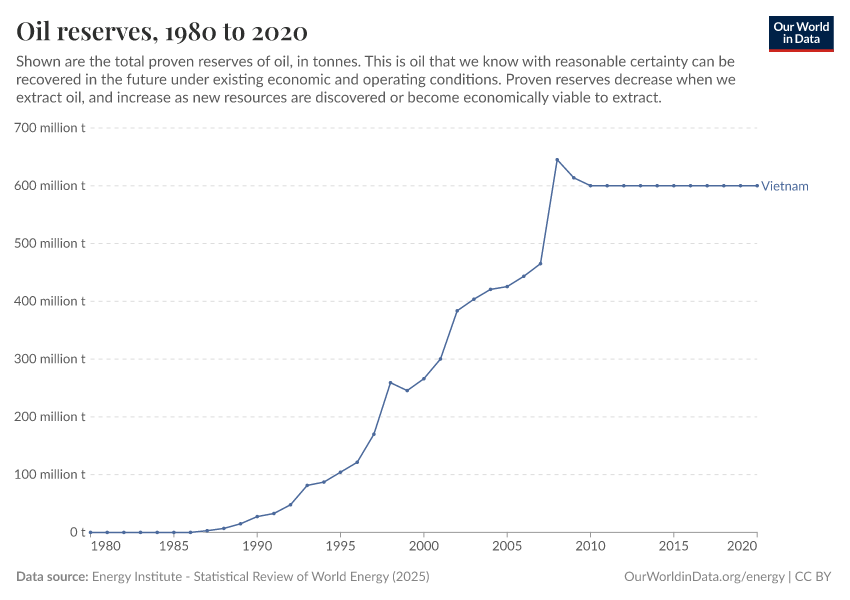Oil proved reserves

What you should know about this indicator
Estimates have been compiled using a combination of primary official sources, third-party data from the OPEC Secretariat, World Oil, Oil & Gas Journal and Chinese reserves based on official data and information in the public domain. Canadian oil sands 'under active development' are an official estimate. Venezuelan Orinoco Belt reserves are based on the OPEC Secretariat and government announcements. Reserves and R/P ratio for Canada includes Canadian oil sands. Reserves and R/P ratio for Venezuela includes the Orinoco Belt. Saudi Arabia's oil reserves include NGLs from 2017. Total proved reserves of oil are generally taken to be those quantities that geological and engineering information indicates with reasonable certainty can be recovered in the future from known reservoirs under existing economic and operating conditions. The data series for total proved oil reserves does not necessarily meet the definitions, guidelines and practices used for determining proved reserves at company level, for instance as published by the US Securities and Exchange Commission, nor does it necessarily represent BP's view of proved reserves by country. Reserves-to-production (R/P) ratio: If the reserves remaining at the end of any year are divided by the production in that year, the result is the length of time that those remaining reserves would last if production were to continue at that rate. Reserves include gas condensate and natural gas liquids (NGLs) as well as crude oil.
What you should know about this indicator
Estimates have been compiled using a combination of primary official sources, third-party data from the OPEC Secretariat, World Oil, Oil & Gas Journal and Chinese reserves based on official data and information in the public domain. Canadian oil sands 'under active development' are an official estimate. Venezuelan Orinoco Belt reserves are based on the OPEC Secretariat and government announcements. Reserves and R/P ratio for Canada includes Canadian oil sands. Reserves and R/P ratio for Venezuela includes the Orinoco Belt. Saudi Arabia's oil reserves include NGLs from 2017. Total proved reserves of oil are generally taken to be those quantities that geological and engineering information indicates with reasonable certainty can be recovered in the future from known reservoirs under existing economic and operating conditions. The data series for total proved oil reserves does not necessarily meet the definitions, guidelines and practices used for determining proved reserves at company level, for instance as published by the US Securities and Exchange Commission, nor does it necessarily represent BP's view of proved reserves by country. Reserves-to-production (R/P) ratio: If the reserves remaining at the end of any year are divided by the production in that year, the result is the length of time that those remaining reserves would last if production were to continue at that rate. Reserves include gas condensate and natural gas liquids (NGLs) as well as crude oil.
Sources and processing
This data is based on the following sources
How we process data at Our World in Data
All data and visualizations on Our World in Data rely on data sourced from one or several original data providers. Preparing this original data involves several processing steps. Depending on the data, this can include standardizing country names and world region definitions, converting units, calculating derived indicators such as per capita measures, as well as adding or adapting metadata such as the name or the description given to an indicator.
At the link below you can find a detailed description of the structure of our data pipeline, including links to all the code used to prepare data across Our World in Data.
Reuse this work
- All data produced by third-party providers and made available by Our World in Data are subject to the license terms from the original providers. Our work would not be possible without the data providers we rely on, so we ask you to always cite them appropriately (see below). This is crucial to allow data providers to continue doing their work, enhancing, maintaining and updating valuable data.
- All data, visualizations, and code produced by Our World in Data are completely open access under the Creative Commons BY license. You have the permission to use, distribute, and reproduce these in any medium, provided the source and authors are credited.
Citations
How to cite this page
To cite this page overall, including any descriptions, FAQs or explanations of the data authored by Our World in Data, please use the following citation:
“Data Page: Oil proved reserves”, part of the following publication: Hannah Ritchie, Pablo Rosado, and Max Roser (2023) - “Energy”. Data adapted from Energy Institute. Retrieved from https://archive.ourworldindata.org/20250909-093708/grapher/oil-proved-reserves.html [online resource] (archived on September 9, 2025).How to cite this data
In-line citationIf you have limited space (e.g. in data visualizations), you can use this abbreviated in-line citation:
Energy Institute - Statistical Review of World Energy (2025) – with major processing by Our World in DataFull citation
Energy Institute - Statistical Review of World Energy (2025) – with major processing by Our World in Data. “Oil proved reserves” [dataset]. Energy Institute, “Statistical Review of World Energy” [original data]. Retrieved January 2, 2026 from https://archive.ourworldindata.org/20250909-093708/grapher/oil-proved-reserves.html (archived on September 9, 2025).